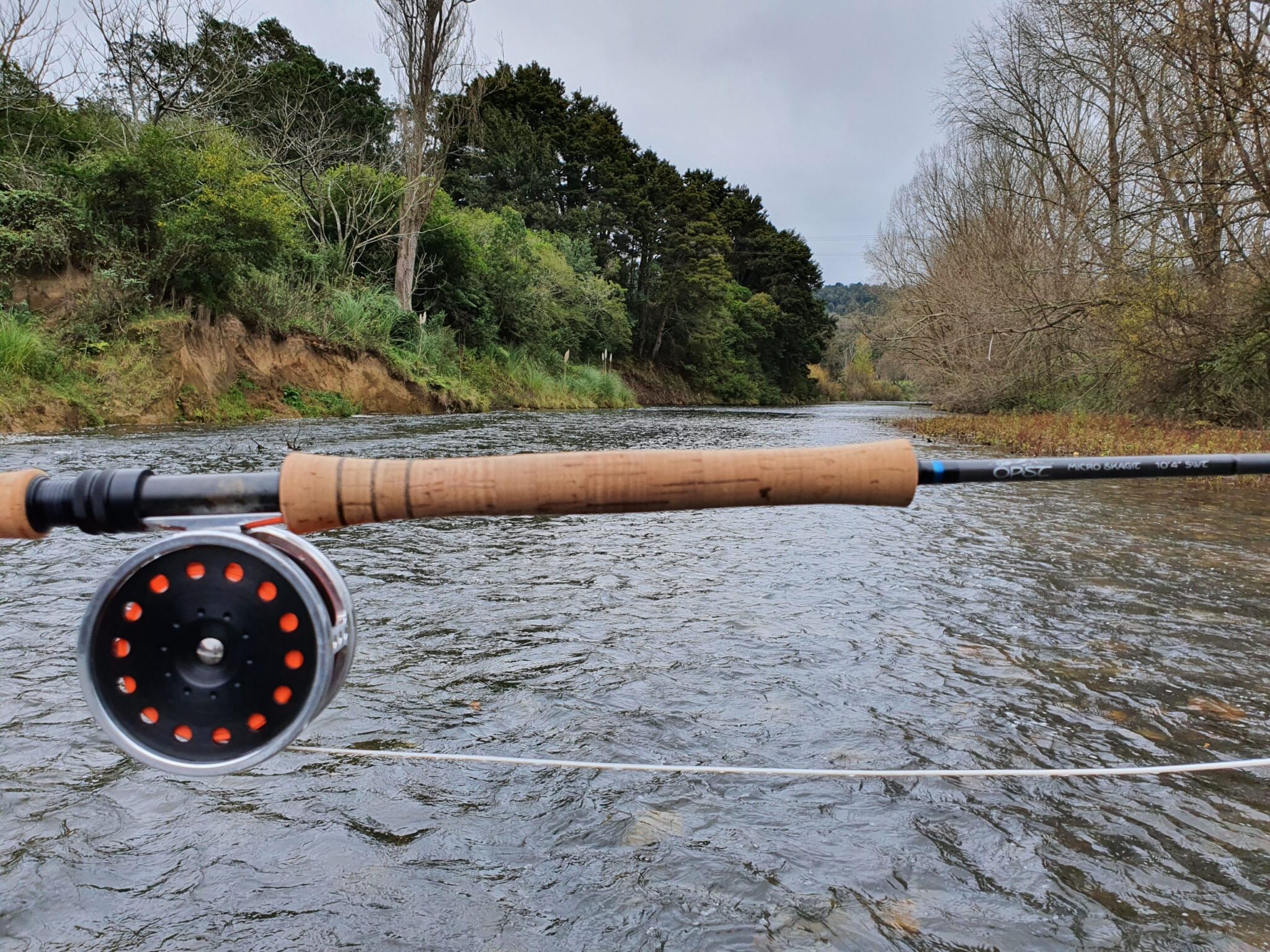- Empty cart.
- Continue Shopping

Confessions of a Gear Junkie
If you could only have one, which weight would you go?
Like many fly fishermen, fisherwomen, fishers or just people who fish that I know and have ties with, the question resonates – which weight rod is ideal? I commonly come across forum threads and am asked the fundamental question – if I wanted to buy a double-handed rod, which weight should I choose to cover the most bases? Of course, many questions need to be asked – how big is water? How deep do you want to get down? How behemoth are the fish? And how long do you want to spend at a pond or park honing your technique?
While mulling these important questions over, as a little bit of a gear junkie my mind forgets the single rod and envisages two main routes – even numbers and odd numbers!
I mean if you buy a 5wt, then you can end up later going 3, 5 and 7, or perhaps look at a 6wt and then you’ll naturally end up 4, 6 and 8. That’s not even taking into consideration a few of the really big rivers we have here that require a full Spey rod to get across!
I have always found that there is something so mystical and alluring about new fly fishing gear. I am not consigned to the idea that if I get a shiny new rod with “insert jargon here,” my casting will be that much tighter and my tailing loops a distant memory. I try to spend more time at the pond practising to do this – I learnt that the hard way with my brief run-in with golf which I think is closely on par with fly fishing for the promise of gear to ability! NEW CLUBS DID NOT MAKE THE BALL GO STRAIGHTER!!
I do, however, just dream of how utterly necessary that 3wt Micro Spey rod would be to compliment my existing 5wt! Also, how paramount the 8wt that now often sits in the cupboard gathering dust is for pushing out a heavy head and driving a heavy piece of tungsten embedded line and lead eyed Intruders on those days when the wind is barreling down the river. To make matters worse, I do ponder the inclination that although a 5wt is in so many ways too similar between the 4 and the 6, I would just bloody love a 4wt and a 6wt!
I guess in essence, there is that feeling that as you get more proficient at something, there is a tendency to want to shave as much fat off as possible; it becomes the balance of improvement and finding that baseline- the line where you don’t lose your original purpose, but instead, feel you are progressing your gear with your ability to become as unrestrictive as possible.
I find this to be essentially true with the trend for double-handed rods. Many people start with an eight weight they are sold or buy as part of some kind of package. They get the casting going, start enjoying the experience of swinging flies; then those sweet, sweet takes start coming and the addiction builds. More and more fish are put in the net or pulled into the shallows and over time the bigger fish tend to be remembered increasingly more, and the stock standard average-sized fish start to lose a little of their sheen. And then, as if by inception, a little spark to a chain of thought emerges: “this would be a bit more fun on a lighter rod!” And it begins – the trim down – the mass consumption and consumerism!
These days, this thought is usually followed up by a heavy binge of Internet surfing. Oh, the Internet! What a wonderful place! Our access to information is the best it’s ever been! Disregarding cat memes and the type of browsing that needs cleared search records, we can go to somewhere with great Kiwi ingenuity great like NZ Trout App and find fishing access points, hire a guide and even find a boutique, NZ made sunscreen. Or we can delve into the myriad of product reviews, wade through the advertising, and get involved in long-winded discussions of which rod weight we should buy. As helpful as they can be, they often turn into a ‘mish-mash.’ I commend people for helping others and respect them for giving their time and expertise to help someone who genuinely wants to make the “correct” decision! However, I have found more often than not, the person buying already has their mind made up and just wants to find some confirmation that they are making the “right” choice, and others use it as a chance to take a stab to up their brand while taking potshots at the competition. A simple “which rod weight should I buy?” can become a which brand is best and why you shouldn’t fish “X” brand of line. While filtering through all that though, there is some great information from really knowledgeable people who have done some serious on river trialling and the buying necessary to achieve this who genuinely want to help people avoid the pitfalls they made in the process and stop people amassing the clutter of rods they have out in the garage.
I’ve found a lot of people looking to get into the double-handed game get quite confused with the rod lingo – Spey, Switch, Micro Spey…. The whole “Switch” rod name has always felt like an absolute marketing ploy to me. Instead of a shorter, lighter Spey rod for swinging flies, it is a shorter, lighter Spey rod for swinging flies that you can be sold a weight forward line for nymphing to carry around in your bag or put in the cupboard. I have seen quite a lot of negative effects ripple on from that term. It’s a great word to make people feel they are getting value for money – a bit like a Swiss Army knife. It opens up a multi-purpose world where the promise of more utility makes people want to bite and rings in another sale. However, apart from the lightest of weights, I can’t think of much worse than spending an afternoon nymphing bombs on the Tongariro with an 8wt Switch rod! This is probably part of the reason, you were looking for a switch rod in the first place, right? As you wanted a change from this style of fishing and wanted to try something new. I mean you could probably tie a tapered leader on the tip and triple it up as a Tenkara rod, but there is no point testing out your religious proclivities.
That’s why I like the term Micro-Spey; it alludes to the fact that once you buy a double-handed rod, you are probably never going actually use it for any other purpose than swinging flies – just in a lighter, shorter manner than a full Spey rod!
At the end of the day for winter fishing, the right choice is the weight of rod that is going to allow you to comfortably cast the sink tip with the density of tungsten that is needed to really get down and dirty and get into some fish. If you didn’t need to get down to get into the fish, people wouldn’t throw “chuck and duck” nymphs with a piece of fluff the size of a budgie, and we wouldn’t need sausage-shaped Skagit heads to drive tips with enough tungsten to produce the lights of a mansion. Add tungsten cone head or lead eyed flies to the equation and you add another level of clunkiness, which going up a rod weight and using a heavier head can combat. Good casting can help you drive such rigs more efficiently of course, so the more willing you are to work on technique, the more likely you can handle a little more weight on lower-rated rods. Grain windows can be quite wide on rods and it can depend on how you cast and what action you want in your rod, but usually, the upper mid-section of a grain window is probably a safe bet to start with for a Skagit style suited best suited for winter style fishing with heavy sink tips. I have a 13 foot 5/6 weight that I have experimented on with heads ranging from 325 up to 450gr. It casts all of these effectively with a 132gr, 12ft sink tip (T11). But for someone new, I’d give them a 400gr and that would be supple enough to snap the line over effortlessly but still give them a good feel of the rod’s load. The thing is though, I’ve been fishing a demo 11ft 5wt double-handed rod lately, and it has been so nice. It easily casts a decent sink tip and has been an awesome fish fighter. It seems ample for rivers like the Tongariro, except on the very windy days perhaps, or when I want to throw some heavy lead, so I’m coming back to the drawing board of 3, 5, 7 or 4, 6, 8!?
Whether to get in there with a cheaper alternative to start with and then upgrade later is an important consideration and literally depends on how deep your coffers are. A cheaper rod is going to get you out there on the water fishing whereas reading countless product reviews is going to get you out there buying reading glasses sooner rather than later. There are some great lower priced options these days. I bought my first double-handed rod knowing that I was going to like it, and with the proclivity that as soon as I justified liking it, I would be getting ready to upgrade it and put it on Trademe. I did, found a happy buyer looking to start out as I did and never looked back! But, when I look at my collection of rods build, however, it does give me admiration for someone close to me who has an abundant source of carbon wands to experiment with that is still fishing the exact same entry-level rod he started on and to tell you absolute truth – THE BLOODY TROUT HAVENT EVEN NOTICED!!!
Of course, a new rod means new line sizes and reels and spools to house these! Spools are expensive, so there is the tendency to start with a cheap reel to simply act as a storage facility. But the problem with cheaper reels is that line running lines, especially the beautiful slick mono lines that shoot like a Lazar, tend to slip out.
Then the revelation of a full-cage reel to solve this issue appears as if from the heavens; then the sound of a classic styled roaring clicker drag reverberates through the skies; the gleam of the polished chrome of a Speyco glints in the sun. And with all of it the dream of new, beautiful shiny gear – the scouring of websites for gear reviews, the twisting and turning of internet forums, the growing watchlist of Trademe auctions, hidden receipts, concealed purchases and deliveries to work addresses, compromises echoing you need a new reel as much as she needs that designer handbag – all the signs of a true gear junky – or just another fisherman taken Intruder, head and tip!
If this resembles you, remember – YOU ARE NOT ALONE!
As I write this with my place in the ring of wooden seats at the local community hall, I realize that I really, really do have a problem! I’ve had the OPST 5wt in my grasp for some time now and absolutely love it, but I still can’t shake the feeling of needing a 3wt for Summer small bug swinging and a 4wt for the in-between and perhaps even a 6wt for those windy days! Gotta catch them all!
Gear to collect:
Here are some products to check out to build your collection of swinging gears:
For the 3,4,5’s!
OPST Micro Skagit Rods 3-5wt– As I alluded to, these really are beautiful wands!
https://bit.ly/OPSTmicroskagit
Traper GST Reel – For a lightweight Full cage reel option that can also perfectly fit the multi-purpose angler!
Speyco 3.25″ – For the swing enthusiast who wants a bulletproof reel with the sweet roar of the drag for every take!
To match a 3/4wt or single-hand rod
Speyco 3.5″
To match a 5/6wt
OPST Pure Skagit Rods
For the bigger guns 6wt+
https://bit.ly/OPSTPureSkagitRods
Speyco 3.75″
A fine reel to match the bigger guns
Simon
Simon is a keen enthusiast for fly fishing, especially all things trout Spey and Skagit style tactics. He's a keen fly tyer, with a strong focus on tube flies, leech and Intruders style patterns. He has been with Iloveflyfishing since the early days and has been a key ambassador for OPST, Aquaz and Speyco as well as all of the ILFF catalogue. He is also a man-keen saltwater fly fisher and can often be found flicking a Crazy Simon fly around the Auckland region. Simon is a regular contributor to NZ Trout Fisher magazine where you can find his column "On the Swing with Simon"
all author posts




